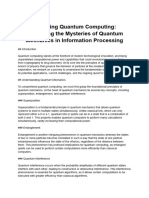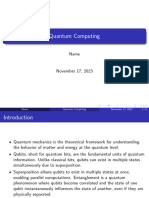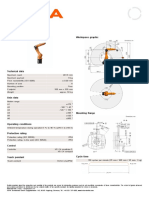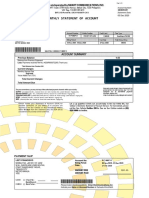Quantum Computing: Comprehensive Notes
1. Introduction to Quantum Computing Quantum computing is an advanced
field of computing based on the principles of quantum mechanics, a
fundamental theory in physics. Unlike classical computers that use bits to
represent data as 0s or 1s, quantum computers use quantum bits or qubits, which
can represent both 0 and 1 simultaneously due to a property known as
superposition.
2. Key Principles of Quantum Mechanics
Superposition: This principle allows quantum systems to be in multiple
states at the same time. In quantum computing, qubits can be in a state of
0, 1, or any combination of both, enabling quantum computers to process
complex data more efficiently than classical computers.
Entanglement: When qubits become entangled, the state of one qubit is
dependent on the state of another, even when they are separated by large
distances. This unique property enables powerful parallel computations
and information correlation.
Quantum Interference: Used to control the probability of a quantum
system's outcome. Quantum algorithms exploit this to cancel out
incorrect solutions and reinforce correct ones.
3. Quantum Bits (Qubits)
∣ψ⟩=α∣0⟩+β∣1⟩|\psi\rangle = \alpha|0\rangle + \beta|1\rangle∣ψ⟩=α∣0⟩+β∣1⟩
Unlike classical bits that are either 0 or 1, a qubit can be represented as:
where α\alphaα and β\betaβ are complex numbers that describe the
probabilities must satisfy the condition: ∣α∣2+∣β∣2=1|\alpha|^2 + |\beta|^2 =
probability amplitudes of the qubit being in state 0 or 1, respectively. The
1∣α∣2+∣β∣2=1
4. Quantum Gates and Circuits
Quantum Gates: Analogous to classical logic gates but operate on qubits
using quantum mechanics. Common gates include:
o Pauli-X Gate: Flips the state of a qubit.
o Hadamard Gate (H): Creates a superposition state from an initial
state.
o CNOT Gate: A two-qubit gate that flips the second qubit if the
first is in state 1 (used in entanglement).
� Quantum Circuits: Combinations of quantum gates form circuits, which
are sequences of operations that modify qubits to solve problems.
5. Quantum Algorithms
Shor’s Algorithm: Used for integer factorization. It can break
cryptographic codes based on the difficulty of factoring large numbers,
such as RSA encryption.
Grover’s Algorithm: Provides a quadratic speedup for unstructured
search problems, finding an item in an unsorted database in O(N)O(\
sqrt{N})O(N) time compared to O(N)O(N)O(N) for classical algorithms.
Quantum Fourier Transform (QFT): The quantum version of the
discrete Fourier transform, used in many quantum algorithms for
problems like phase estimation.
6. Applications of Quantum Computing
Cryptography: Shor’s algorithm poses a threat to current encryption
methods, leading to the development of post-quantum cryptography.
Optimization Problems: Quantum computers can solve complex
optimization problems more efficiently, which is valuable in fields such
as logistics, finance, and supply chain management.
Drug Discovery and Material Science: Quantum simulations can model
complex molecular and atomic interactions, which could lead to
breakthroughs in drug development and the creation of new materials.
Artificial Intelligence and Machine Learning: Quantum machine
learning algorithms may accelerate training and improve the efficiency of
models.
Weather Forecasting: Quantum computers can process vast datasets to
create more accurate climate models.
7. Quantum Hardware
Superconducting Qubits: Use superconducting circuits cooled to near
absolute zero to exhibit quantum mechanical properties.
Trapped Ions: Use individual atoms suspended in electromagnetic fields,
with laser pulses to manipulate their quantum state.
Topological Qubits: Utilize anyons, particles with unique properties that
could offer better error correction and stability.
� Photonic Qubits: Use photons to represent qubits, offering advantages in
speed and potential integration with optical technologies.
8. Challenges in Quantum Computing
Quantum Decoherence: Qubits are highly sensitive to their environment
and lose their quantum state quickly, leading to errors.
Error Correction: Requires complex algorithms and many physical
qubits to create a logical qubit with error correction.
Scalability: Building a quantum computer with a significant number of
qubits while maintaining their entangled state is a significant technical
challenge.
Cost and Engineering: Quantum hardware requires advanced and
expensive cooling systems and precise control equipment.
9. Current State and Future Prospects
Current Status: Major tech companies (e.g., IBM, Google, and Rigetti)
and startups are actively developing quantum processors. Quantum
computers have reached milestones like achieving quantum supremacy,
where they outperform classical computers in specific tasks.
Quantum Supremacy: Demonstrated when Google’s 53-qubit quantum
computer, Sycamore, performed a computation in 200 seconds that would
have taken the most advanced classical supercomputer thousands of
years.
Future Outlook: The next phase involves quantum advantage, where
quantum computers solve practical, real-world problems more efficiently
than classical computers.
10. Quantum Computing Languages and Tools
Qiskit (IBM): An open-source framework for working with quantum
circuits and running simulations.
Cirq (Google): A Python library for creating, editing, and invoking
quantum circuits.
Forest (Rigetti): Includes the PyQuil library for quantum programming
and access to Rigetti’s quantum processors.
Microsoft’s Q#: A quantum programming language designed for writing
scalable quantum algorithms.
�Conclusion Quantum computing holds the promise to revolutionize many
aspects of technology and industry. While still in its early stages, its potential
for solving complex problems far beyond the capabilities of classical computers
makes it a critical area of research and development.
























































































